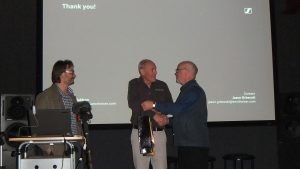Meeting Report
Wireless Microphones – Current Technologies and Where To From Here
On Monday June 6th AES Melbourne members and gathered in the SAE Institute Lecture Theatre to hear James Waldron and Jason Grbevski of Sennheiser Australia to speak on the topic “Wireless Microphones – and Where to From Here?”
James Waldron started with a brief overview of Sennheiser’s history and current operations, as well as the history of wireless microphones.
James then gave a brief overview of the spectrum changes which have recently affected wireless microphones, citing the growth in mobile broadband demand – particularly mobile video streaming – as the driver for the spectrum reallocation activities. He provided details on the new (reduced) allocation for performance-grade wireless microphones (526-694MHz) – spectrum which is shared with television broadcasters.
He then went on to describe the basics of wireless microphone systems, going into detail on the major system components – transmitters, receivers and antennas, commenting that frequency modulation (FM) has, for a long time, been the mainstay of wireless microphones providing high quality, low noise audio.
Then he covered the licencing requirements, particularly the maximum power and bandwidth restrictions, noting that the local Low Interference Potential Device (LIPD) licencing allows only 330kHz RF bandwidth and the ETSI standard EN300422 further restricts it to 200kHz. He commented that this gives designers some restrictions in what they can deliver – particularly with audio quality.
James then briefly covered Shannon’s Theory, pointing out that channel data channel capacity is limited by channel bandwidth and noise level.
He then described how techniques like high-frequency pre-emphasis/de-emphasis and dynamic range compression/expansion (“companders”) were used to improve the audio performance of FM wireless microphones.
Then he described diversity reception using multiple antennas and auto-switching to improve reliability.
He followed this with an examination of issues associated with intermodulation products of multiple frequencies, and the protection offered by adding circulators to RF output stages.
James then moved on discuss the move to digital, suggesting the perceived benefits (“perfect” audio quality, no more compander artefacts, best S/N ratio, and best frequency response). He then brought us back to earth by reminding us of the work of Claude Shannon, and that with the regulatory 200kHz bandwidth high audio quality is not achievable without special high density modulation techniques. He then described how the phase and amplitude can be modified simultaneously to impress as much information as possible on an RF carrier.
He then mentioned the design constraints which affected wireless microphones in a range of applications, and presented some Sennheiser products designed for use in specific cases.
James then passed over to Jason Grbevski to talk about the future of the technology.
Jason started out by identifying the user landscape, particularly the newer users like amateur film makers, vloggers, and video journalists.
He then highlighted that the spectrum “thirst” is increasing while the availability is decreasing, demonstrating that the manufacturers need to adapt, identifying ways to use spectrum more efficiently.
He enumerated the additional spectrum bands beyond UHF that wireless mics now also inhabit – 900MHz ISM, 1.8GHz ISM, 2.4GHz, and 1.9MHz DECT, described the pluses and minus of each, and typical applications for equipment working in each band. He particularly went into great detail about the relatively new use of the DECT (Digital Enhanced Cordless Telecommunications) standard by Sennheiser.
He then discussed the possible future, with an ever increasing demand for spectrum with wifi potentially expanding up to 60GHz, and more worryingly 802.11AH standard for long-range/low data rate devices (eg: Internet of Things devices) which threatens the 900MHz band.
On top of all this, he discussed that the biggest threat was to the 526-694MHz performance-grade devices, with the proposal for White-Fi (802.11af)- where “white-space” in the TV spectrum is used for data transmission. He suggested that this poses a great threat to wireless microphones’ UHF spectrum.
He then proposed the possibility of utilizing wi-fi networks for wireless microphones, and listed the challenges associated with this, suggesting that it may happen one day, but there was a lot of work needed to address the issues.
The evening concluded with a Q&A.

A video has been assembled of the talk, covering the Powerpoint slides+audio:
This video can also be viewed directly on YouTube at:
https://www.youtube.com/watch?v=koaMW-xwSeE
A PDF copy of the slides presented can be viewed or downloaded here.
and
The audio-only recording can be heard or downloaded here.
Links:
Spectrum location resources
ACMA’s TV channel use locator https://myswitch.digitalready.gov.au/
Sennheiser’s frequency finder web app http://www.frequencyfinder.com.au/
Information on the White-Fi development.
Thanks to Graham Haynes and his trusty Tascam for the audio recording.
A special thanks to the SAE Institute for the use of their excellent facilities.
